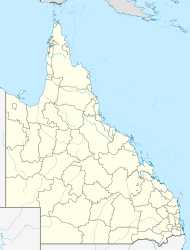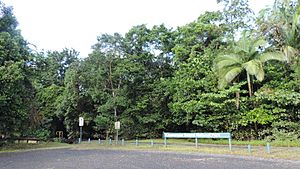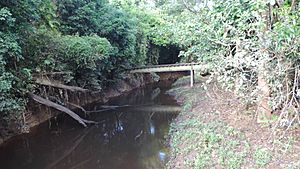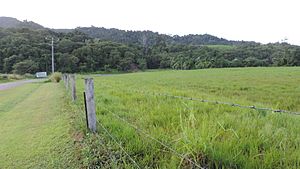Eubenangee, Queensland facts for kids
Quick facts for kids EubenangeeQueensland |
|||||||||||||||
|---|---|---|---|---|---|---|---|---|---|---|---|---|---|---|---|
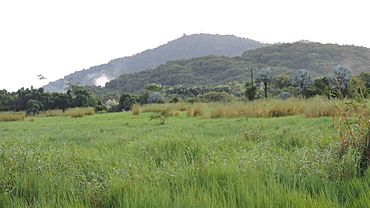
Looking north over fields from Cartwright Road, Eubenangee, 2018
|
|||||||||||||||
| Population | 242 (2016 census) | ||||||||||||||
| • Density | 2.648/km2 (6.86/sq mi) | ||||||||||||||
| Postcode(s) | 4860 | ||||||||||||||
| Area | 91.4 km2 (35.3 sq mi) | ||||||||||||||
| Location |
|
||||||||||||||
| LGA(s) |
|
||||||||||||||
| State electorate(s) | Hill | ||||||||||||||
| Federal Division(s) | Kennedy | ||||||||||||||
|
|||||||||||||||
Eubenangee is a small coastal area in Queensland, Australia. It is special because it is split between two different local government areas: the Cairns Region and the Cassowary Coast Region. In 2016, only 242 people lived there.
Contents
Exploring Eubenangee's Landscape
Most of Eubenangee is in the Cairns Region. A smaller part is in the Cassowary Coast Region. The western side has a large, flat area called a wetland. This wet area is part of the Eubenangee Swamp National Park. Wetlands are important places where water covers the land, helping many plants and animals.
In contrast, the north-eastern part of Eubenangee has mountains. Mount Arthur rises to 470 metres above sea level. This mountainous area is part of the Ella Bay National Park. Most of the land that people use for farming is around the edges of the Eubenangee Swamp National Park. Farmers mostly grow sugarcane here.
Rivers and Water Flow
Eubenangee is a watershed. This means that rain that falls in the northern part of Eubenangee flows into the Russell River. This river then flows into the Coral Sea. Water from the southern part of Eubenangee flows into the North Johnstone River. This river eventually joins the South Johnstone River to form the Johnstone River, which also flows into the Coral Sea.
Roads and Railways
The main road, the Bruce Highway, and the North Coast railway both pass through the south-east of Eubenangee. The Waugh railway station serves this area. You might also see a special cane tramway here. These small railways are used to carry harvested sugarcane to the local sugar mills for processing.
Eubenangee's Past
The name "Eubenangee" comes from the railway station. The Queensland Railways Department named the station Eubenangee on August 15, 1918. The railway station itself was named after the large Eubenangee Swamp nearby.
A school called Eubenangee Provisional School opened in September 1921. It later became Eubenangee State School in 1927. However, the school closed its doors in 1971. In 2016, the population of Eubenangee was 242 people.
Where Kids Go to School
There are no schools directly in Eubenangee today. Children living here usually go to primary school in nearby towns. The closest primary schools are Mirriwinni State School in Mirriwinni to the north-east, and Goondi State School in Goondi Bend to the south-west.
For high school, students can attend Babinda State School in Babinda to the north-west. This school teaches students from Prep (the first year of school) all the way to Year 12. Another option is Innisfail State College in Innisfail Estate to the south-east.


